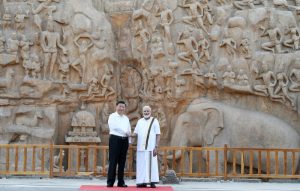
Defeating the coronavirus pandemic in record time, China’s top leadership has unveiled its vision of making the nation into a technological powerhouse and the hub of cutting-edge innovation. This overarching vision, with its focus on quality of growth, has been encapsulated in the 14th five-year plan adopted by the Communist Party’s Central Committee 5th plenum.
In comparison to the last five-year plan, which stressed on achieving “medium-to-high growth” in order to build a “moderately prosperous society,” this plan focuses on quality rather than the pace of growth.
The plan also prioritises sustainable growth and developing a robust domestic market. The big message emanating from the 14th five-year plan is that unfazed by the pandemic, China’s top brass is determined to accelerate the transformation of China into a major global power. Integral to this vision is China’s confident ambition to achieve self-reliance in technology.
“Making major breakthroughs in core technologies in key areas, China will become a global leader in innovation,” says the communique published by Xinhua.
China should focus on promoting high-quality development during its 14th Five-Year Plan period, President Xi Xinping said. This is based on the scientific assessment of the stage, environment, and conditions for the country’s development.
To forestall and defuse various kinds of risks and proactively address challenges brought by external changes, China needs to focus on taking care of its own matters and improving the quality of development, said President Xi.
The CPC Central Committee’s proposals for formulating the 14th Five-Year Plan (2021-2025) for National Economic and Social Development and the Long-Range Objectives Through the Year 2035 were adopted at the fifth plenary session of the 19th CPC Central Committee held in Beijing.
In a speech at the plenum, President Xi Jinping said: “Coordinating the formulation of the 14th Five-Year Plan and the long-range objectives through 2035 is of great significance to mobilizing and motivating the whole Party, the whole nation and people of all ethnic groups to overcome all risks and challenges on the road ahead and getting off to a good start in fully building a modern socialist China.”
The plan was formulated after months of consultations with key stakeholders from various sectors.
The drafting group studied all the comments and suggestions sent to them piece by piece, holding discussions and revising the proposals many times, President Xi said.
Terming the drafting process “a vivid example of the CPC’s intraparty democracy and China’s socialist democracy,” President Xi said that 546 comments and suggestions have been reflected in the proposals.
President Xi underscored properly handling “five relations” — the relations between building on past achievements and seeking innovations, between the government and the market, between opening-up and self-reliance, between development and security and between strategy and tactics — as the principles in drafting the proposals.
President Xi also underscored efforts to remain committed to the new development philosophy, focus on deepening the supply-side structural reform, transform the development model to deliver real benefits to all the people.
The 14th five-year plan will go down in history as an important inflection point where China’s top leadership unambiguously chose quality of growth over quantity and pursuit of sustainable and green development. Going forward, this new development philosophy will continue to drive China’s ascent as a major global power.
Implications for India

The 14th five-year plan has important ramifications for India as going by this plan, the power differential between the two neighbouring countries will grow further, which necessitates cultivation of harmonious bilateral relations. The current border standoff will continue for some time, and India will focus on protecting its sovereignty, but this should not detract from the need to resume normal bilateral interactions. In this regard, resuming strategic economic dialogue will bring the much-needed development dimension to the India-China relations with China. India-China relations can acquire more solidity and stability when the two countries shed paranoia and invest their energy in insulating their development partnership from political vagaries. Promoting mutual development and resurgence should be the driving force of the partnership between the two rising powers. But for this to happen, the two countries need to jointly reject narratives of rivalry and hostility in favour of win-win cooperation.
In an article entitled,” A New Start, A New Journey,” written for India Writes Network, China’s Ambassador to India Sun Weidong underlined that “as the two largest developing countries and emerging economies, China and India face similar development tasks and goals.”
“The common interests between our two countries far outweigh the differences.”
“We should take a far-sighted view, meet each other halfway, build consensus, and join hands in development, strengthen cooperation in areas such as anti-epidemic, economic recovery, multilateralism and global governance. In this way, we could make 2.7 billion people of our two countries live a better life, and make due contributions to safeguarding world peace and stability and promoting common development,” he wrote.
Author Profile

- Manish Chand is Founder and Editor-in-Chief of India Writes Network (www.indiawrites.org) and India and World, a pioneering magazine focused on international affairs. He is CEO, Centre for Global India Insights, an India-based think tank focused on global affairs.
Latest entries
 In ConversationNovember 26, 2025G20 is a Force for global Good
In ConversationNovember 26, 2025G20 is a Force for global Good articlesNovember 26, 2025Rescuing G20 from North-South divide: Ubuntu Moment
articlesNovember 26, 2025Rescuing G20 from North-South divide: Ubuntu Moment India and the WorldOctober 27, 2025Modi hails the century of India and ASEAN, backs ASEAN centrality
India and the WorldOctober 27, 2025Modi hails the century of India and ASEAN, backs ASEAN centrality India and the WorldOctober 26, 2025Act East: Five reasons why ASEAN summit in Malaysia matters
India and the WorldOctober 26, 2025Act East: Five reasons why ASEAN summit in Malaysia matters







